#good fuel economy
Text
2024 Toyota Corolla Cross XSE Hybrid
Need a reliable crossover for a reasonable price, and want hybrid efficiency and AWD? Look no further than Toyota's new Corolla Cross!
Crossover touts reliability, fuel efficiency (38 mpg tested) with hybrid …
Smart marketing in the auto world begins by nurturing the image and reputation of key models to ensure they survive and thrive, thereby delivering a steady stream of profits.
Perfect example, Toyota’s Corolla, which has been a stalwart entry-level sedan for Toyota since I was first buying cars. That’s been awhile. When…

View On WordPress
#2024 Toyota Corolla Cross XSE hybrid#AWD#crossover#EV#good fuel economy#high-value crossover#SE#wireless charger
0 notes
Text

Turnip, the Greatest Prairie Chicken, and chicken chickens (and Hushpuppy)
🤠💖Yeehaw
#doodle#caffe art#western#caffe's cool western#hushpuppy#chicken horse#turnip#chicken#horse#chicken chicken#cause they're double chicken#I drew it with these little Tombow brush pens#and they're so great but disposable wasteful little things#not good for my fuel economy even if beautiful 😔#so they're for doodlin'
173 notes
·
View notes
Text

started mass effect the other day and i wish you could trans the gener of your imported shep between games...... this is lucrezia "luz" shepard and she loves her fishies. her favorite video game is katamari
#she loves doing her hair too always finds an opportunity to touch up her roots#fuel 10000 credits probes 30000 credits box bleach 15000 credits fish food 200000 credits upgrades 750 credits#someone good at the economy please budget this my normandy crew is dying#i think im tagging this as#femshep#mass effect#commander shepard#my art#im only halfway thru me2 no spoilies please mwah#this has been simmering in my mind but she looks like laios dunmeshi pre-transition... i havent even read that yet#oc: luz
29 notes
·
View notes
Text
Unveiling the Efficiency of Motorcycles: The Verucci Nitro 50
https://gob.stayingalive.in/revving-up-knowledge-unveil/unveiling-the-efficiency-of.html
Discover the efficiency of motorcycles with the Verucci Nitro 50, traveling 172 km on one gallon of gas. Explore the balance between performance and fuel economy, and embrace sustainable transportation. #MotorcycleEfficiency #VerucciNitro50 #SustainableTransportation
In a world where sustainability and…

View On WordPress
#cars#Eco-friendly commuting#Environmental consciousness#Fuel efficiency vs. power#Fuel-efficient motorcycles#Good Old Bandit#Gud Ol Bandit#motorcycle#Motorcycle efficiency#Motorcycle fuel economy#Motorcycle performance tradeoffs#Motorcycle technology advancements#Motorcycles#News#Sanjay K Mohindroo#Sanjay Kumar Mohindroo#Sanjay Mohindroo#Sustainable transportation#technology#Verucci Nitro 50
0 notes
Text
one of the things that's the most fucking frustrating for me about arguing with climate change deniers is the sheer fucking scope of how much it matters. sweating in my father's car, thinking about how it's the "hottest summer so far," every summer. and there's this deep, roiling rage that comes over me, every time.
the stakes are wrong, is the thing. that's part of what makes it not an actual debate: the other side isn't coming to the table with anything to fucking lose.
like okay. i am obviously pro gun control. but there is a basic human part of me that can understand and empathize with someone who says, "i'm worried that would lead to the law-abiding citizens being punished while criminals now essentially have a superpower." i don't agree, but i can tell the stakes for them are also very high.
but let's say the science is wrong and i'm wrong and the visible reality is wrong and every climate disaster refugee is wrong. let's say you're right, humans aren't causing it or it's not happening or whatever else. let's just say that, for fun.
so we spend hundreds of millions of dollars making the earth cleaner, and then it turns out we didn't need to do that. oops! we cleaned the earth. our children grow up with skies full of more butterflies and bees. lawns are taken over with rich local biodiversity. we don't cry over our electric bills anymore. and, if you're staunchly capitalist and i need to speak ROI with you - we've created so many jobs in developing sectors and we have exciting new investment opportunities.
i am reminded of kodak, and how they did not make "the switch" to digital photography; how within 20 years kodak was no longer a household brand. do we, as a nation, feel comfortable watching as the world makes "the switch" while we ride the laurels of oil? this boggles me. i have heard so much propaganda about how america cannot "fall behind" other countries, but in this crucial sector - the one that could actually influence our own monopolies - suddenly we turn the other cheek. but maybe you're right! maybe it will collapse like just another silicone valley dream. but isn't that the crux of capitalism? that some economies will peter out eventually?
but let's say you're right, and i'm wrong, and we stopped fracking for no good reason. that they re-seed quarries. that we tear down unused corporate-owned buildings or at least repurpose them for communities. that we make an effort, and that effort doesn't really help. what happens then? what are the stakes. what have we lost, and what have we gained?
sometimes we take our cars through a car wash and then later, it rains. "oh," we laugh to ourselves. we gripe about it over coffee with our coworkers. what a shame! but we are also aware: the car is cleaner. is that what you are worried about? that you'll make the effort but things will resolve naturally? that it will just be "a waste"?
and what i'm right. what if we're already seeing people lose their houses and their lives. what if it is happening everywhere, not just in coastal towns or equatorial countries you don't care about. what if i'm right and you're wrong but you're yelling and rich and powerful. so we ignore all of the bellwethers and all of the indicators and all of the sirens. what if we say - well, if it happens, it's fate.
nevermind. you wouldn't even wear a mask, anyway. i know what happens when you see disaster. you think the disaster will flinch if you just shout louder. that you can toss enough lives into the storm for the storm to recognize your sacrifice and balk. you argue because it feels good to stand up against "the liberals" even when the situation should not be political. you are busy crying for jesus with a bullhorn while i am trying to usher people into a shelter. you've already locked the doors, even on the church.
the stakes are skewed. you think this is some intellectual "debate" to win, some funny banter. you fuel up your huge unmuddied truck and say suck it to every citizen of that shitbird state california. serves them right for voting blue!
and the rest of us are terrified of the entire fucking environment collapsing.
#spilled ink#writeblr#i hope it is clear here that i actually very much care about equatorial countries#and that's part of what makes me so angry bc im like. climate refugees exist.#they've existed for a while!!!#and the reply is almost always ''should have thought about that before living on an island"#like fuck dude. do you need to like how people vote before ur like#your entire house shouldn't burn down each summer????#so many of these people make it their life to mock california that they think it's FUNNY#and im like. girl you should be fucking trembling. TEXAS??? ARE YOU LISTENING??#this is one of those times that like. i need to stress how fucking stupid it would be#to let trump win. bc he could have “reached across the aisle.” covid could have been#a MASSIVE commercial success. he has such a huge and bigoted and brainwashed following.#literally just a PR campaign called COWBOY UP and it's pictures of cowboys in bandanas#trump reinvisioned as the lone ranger fighting for the american people against covid. EASY SELL#and instead. companies bought him. it became political. it was not ''oh shit this is 1 enemy let's all be human''#it was ''you deserve to die.''#climate change should be GLOBAL. it should be like ''yeah i hate u but. we do all live here''#i don't have to LIKE my group members to do well on a team project bc we are ALL getting graded.#is that simple enough of an under-explaination lol
3K notes
·
View notes
Text

They also voted to block to student debt relief, cut tax breaks and subsidies for renewable energy, added work requirements for financial assistance, take back COVID relief money from states, and boost fossil fuel production.
And a very insidious cap on government spending that only grows 1% every year (less than the rate of inflation). Meaning that every year would necessarily require even more cuts.
The worst part is that they made it all a condition for the federal government to pay its debt. Their plan being that if Biden doesn't capitulate to their demands, the US government goes into default, which would cause a global financial crisis.
Oh, and don't think that the 4 Republicans who voted Nay are reasonable. They're voted against it because this bill didn't go far enough for them.
The good news is that the Democrats control the Senate and White House, so this bill won't get enacted.
TL;DR: House Republicans passed an extorsion bill that threatens to blow up the world economy if Biden doesn't capitulate to their demands to hurt poor Americans and make climate change worse.
Abolish the Republican Party!
7K notes
·
View notes
Text
[H]undreds of legal experts and groups on Monday urged the global community—and the United States government in particular—"to comply with international law by ending the use of broad, unilateral coercive measures that extensively harm civilian populations."
In a letter to U.S. President Joe Biden, the jurists and legal groups wrote that "75 years ago, in the aftermath of one of the most destructive conflicts in human history, nations of the world came together in Geneva, Switzerland to establish clear legal limits on the treatment of noncombatants in times of war."
"One key provision... is the prohibition of collective punishment, which is considered a war crime," the letter continues. "We consider the unilateral application of certain economic sanctions to constitute collective punishment."
Suzanne Adely, president of the National Lawyers Guild—one of the letter's signatories—said in a statement that "economic sanctions cause direct material harm not only to the people living on the receiving end of these policies, but to those who rely on trade and economic relations with sanctioned countries."
"The legal community needs to push back against the narrative that sanctions are nonviolent alternatives to warfare and hold the U.S. Government accountable for violating international law every time it wields these coercive measures," she added.[...]
"Hundreds of millions of people currently live under such broad U.S. economic sanctions in some form, including in notable cases such as Cuba, Iran, North Korea, Syria, and Venezuela," the letter notes. "The evidence that these measures can cause severe, widespread civilian harm, including death, is overwhelming. Broad economic sanctions can spark and prolong economic crises, hinder access to essential goods like food, fuel, and medicine, and increase poverty, hunger, disease, and even death rates, especially among children. Such conditions in turn often drive mass migration, as in the recent cases of Cuba and Venezuela."
For more than 64 years, the U.S. has imposed a crippling economic embargo on Cuba that had adversely affected all sectors of the socialist island's economy and severely limited Cubans' access to basic necessities including food, fuel, and medicines. The Cuban government claims the blockade cost the country's economy nearly $5 billion in just one 11-month period in 2022-23 alone. For the past 32 years, United Nations member states have voted overwhelmingly against the U.S. embargo on Cuba. Last year's vote was 187-2, with the U.S. and Israel as the only dissenters.
According to a 2019 report from the Center for Economic and Policy Research, a progressive think tank based in Washington, D.C., as many as 40,000 Venezuelans died from 2017-18 to U.S. sanctions, which have made it much more difficult for millions of people to obtain food, medicine, and other necessities.
"Civilian suffering is not merely an incidental cost of these policies, but often their very intent," the new letter asserts. "A 1960 State Department memo on the embargo of Cuba suggested 'denying money and supplies to Cuba, to decrease monetary and real wages, to bring about hunger, desperation, and overthrow of government.'"
"Asked whether the Trump administration's sanctions on Iran were working as intended, then-Secretary of State Mike Pompeo responded that 'things are much worse for the Iranian people, and we're convinced that will lead the Iranian people to rise up and change the behavior of the regime,'" the signers added.
12 Aug 24
339 notes
·
View notes
Text

Via NasAlSudan
Learn about the Sudanese revolution, the significance of December 19, and a legacy of resistance and resilience.
Join our call to action today and everyday during Sudan Action Week.
December 19 2023

Transcript:
Breaking it down
What is the Sudanese Revolution?
The Sudanese Revolution refers to the popular uprising in Sudan that began on December 19, 2018 and eventually deposed 30-year dictator of Sudan, Omar al-Bashir, on April 11 of 2019.
How did the Revolution begin?
Protests first began in Atbara, a city with historical significance to the labor movement in Sudan, in response to the rising costs of basic supplies such as bread and fuel.
Protestors set fire to the national party headquarters, and the news of their revolt quickly spread, inspiring protestors first in other cities, and then in the capital of Khartoum itself.
Online, the caption #TasgutBas, translating to #JustFall, grew in popularity and helped connect the diaspora to those in Sudan.
Was it really just bread?
No. The rising cost of bread in developing nations is an indicator of how badly the economy is strained, to the point where it impacts members of every social class.
At this point in time in Sudan, subsidies on essential goods had been rolled back, funding for social and state services such as healthcare and education was nearly nonexistent, and it is estimated that nearly 90% of economic activity took place in the informal sector, all while the military budget continually increased.
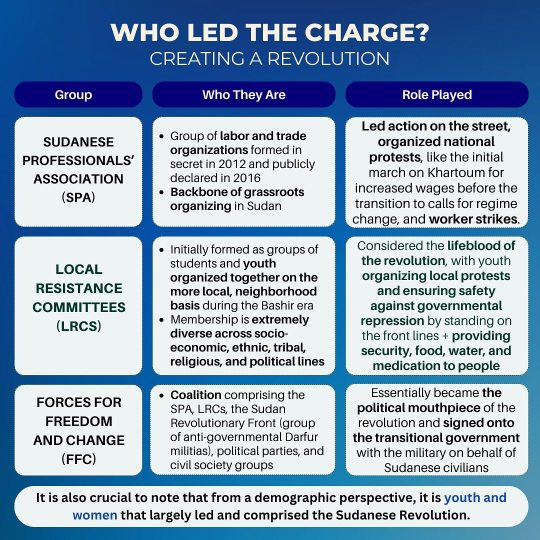
Transcript:
Who led the charge? Creating a revolution
Group: Sudanese Professional's association (SPA)
Who they are:
Group of labor and trade organizations formed in secret in 2012 and publicly declared in 2016
Backbone of grassroots organizing in Sudan
Role played:
Led action on the street, organized national protests, like the initial march on Khartoum for increased wages before the transition to calls for regime change, and worker strikes.
Group: Local Resistance Committees (LRCS)
Who they are:
Initially formed as groups of students and youth organized together on the more local, neighbourhood basis during the Bashir era
Membership is extremely diverse across socio-economic, ethnic, tribal, religious, and political lines
Role played:
Considered the lifeblood of the revolution, with youth organizing local protests and ensuring safety against governmental repression by standing on the front lines + providing security, food, water, and medication to people
Group: Forces for freedom and change (FFC)
Who they are:
Coalition comprising the SPA, LRCS, the Sudan Revolutionary Front (group of anti-governmental Darfur militias), political parties, and civil society groups
Role played:
Essentially became the political mouthpiece of the revolution and signed onto the transitional government with the military on behalf of Sudanese civilians
It is also crucial to note that from a demographic perspective, it is youth and women that largely led and comprised the Sudanese Revolution.

Trabscript:
How did the revolution succeed?
01. Learning from the Past
Following the Arab Spring wave, Sudan also attempted a revolution in September of 2013
Civilians faced violent crackdowns within the first three days of protest. 200 killed, 800+ arrested
Activists were deterred from mobilization + felt a lot of guilt at the massive loss of life and spent the next 5 years grounding themselves in the study of nonviolent theory and action
02. Building a Movement
Coalition Building and People Power
Diversification of the reach of the movement to make sure all sectors of Sudani society were represented
Decentralization of Activism
Past revolutions in 1964 and 1985 were concentrated in the labor movement and educational elites in Khartoum
This time, experienced nonviolent activists trained those in the capital and ensured ethnic, religious, and tribal diversity
Newly trained activists then taught others locally across the Sudanese states

Transcript:
Why december 19?
On December 19, 1955, the Sudanese parliament unanimously adopted a declaration of independence from the Anglo-Egyptian colonial power.
The declaration went into effect on January 1, 1956, which is why Independence Day is officially January 1, but December 19 is when the Sudanese people were truly liberated from colonial rule.
The flag shown is Sudan's independence flag. The blue is for the Nile, the yellow for the Sahara, and the green for the farmlands.
The current Sudanese flag was adopted in 1970, with the colors used being the Pan-Arab ones.
During the 2019 revolution, protestors often carried the independence flag instead as a form of resistance to the narrative of an exclusive Pan-Arab Sudanese identity.
December 19 is ultimately a tribute to Sudanese strength and resilience. It honors our independence and revolutionary martyrs - not just those of the 2019 revolution, but the democratic revolutions of 1964 and 1985 as well.

Transcript:
Why is the revolution ongoing?
The goal was never just the fall of a dictator. The goal was, and is, to build a better Sudan, one free from military rule. One with equal opportunities for everyone, with economic prosperity and safety and security - the key principles of freedom, peace, and justice that the revolution called for.
Today, though, before we rebuild Sudan, before we free it from foreign interests and military rule and sectarianism, we need to save it. Each day that passes by with war waging on is one where more civilians are killed. More people are displaced. More women are raped. More children go hungry. To live in the conflict zones in Sudan right now - whether that be Khartoum, Darfur, Kordofan, or now, Al Gezira, is to be trapped in a never-ending nightmare, a fight for survival. And to live elsewhere in Sudan is to wonder whether you're next.
Sudan Action Week calls on you to educate yourself and others about Sudan, and then to help the Sudanese people save it, because we can no longer do it alone.
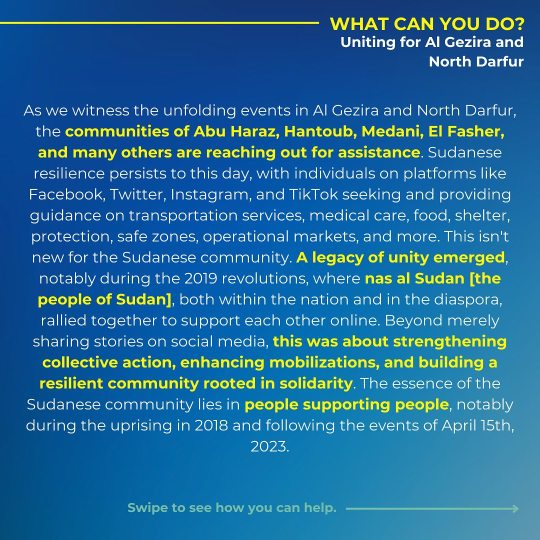
Transcript:
What can you do? Uniting for Al Gezira and North Darfur
As we witness the unfolding events in Al Gezira and North Darfur, the communities of Abu Haraz, Hantoub, Medani, El Fasher, and many others are reaching out for assistance. Sudanese resilience persists to this day, with individuals on platforms like Facebook, Twitter, Instagram, and TikTok seeking and providing guidance on transportation services, medical care, food, shelter, protection, safe zones, operational markets, and more. This isn't new for the Sudanese community. A legacy of unity emerged, notably during the 2019 revolutions, where nas al Sudan [the people of Sudan], both within the nation and in the diaspora, rallied together to support each other online. Beyond merely sharing stories on social media, this was about strengthening collective action, enhancing mobilizations, and building a resilient community rooted in solidarity. The essence of the Sudanese community lies in people supporting people, notably during the uprising in 2018 and following the events of April 15th, 2023
Swipe to see how you can help.
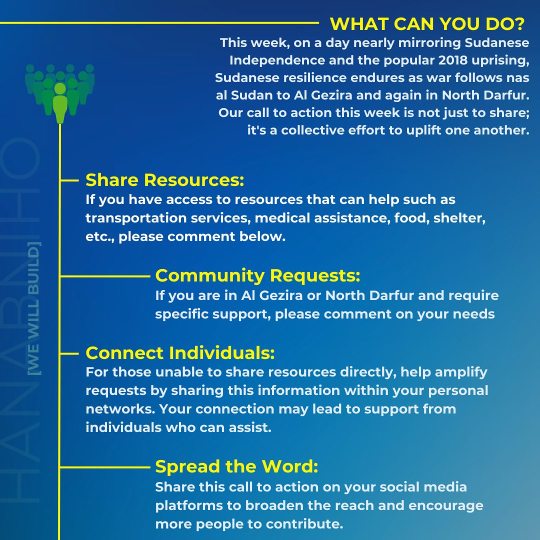
Transcript:
What can you do?
This week, on a day nearly mirroring Sudanese Independence and the popular 2018 uprising, Sudanese resilience endures as war follows nas al Sudan to Al Gezira and again in North Darfur. Our call to action this week is not just to share; it's a collective effort to uplift one another.
Share Resources:
If you have access to resources that can help such as transportation services, medical assistance, food, shelter, etc., please comment below.
Community Requests:
If you are in Al Gezira or North Darfur and require specific support, please comment on your needs
Connect Individuals:
For those unable to share resources directly, help amplify requests by sharing this information within your personal networks. Your connection may lead to support from individuals who can assist.
Spread the Word:
Share this call to action on your social media platforms to broaden the reach and encourage more people to contribute.

Transcript:
Hanabniho
حنبنيهوا
[We will rebuild]
#keepEyesOnSudan
#SudanActionWeek
924 notes
·
View notes
Text
Sometimes I think it's underrated how much of Westeros we see during wartime. Amidst all of the discourse back and forth over whether the brutality of ASOIAF has a "realistic" basis in real-life feudal history, I think the fact that we're seeing Westeros in a very atypical and specific circumstance should not go overlooked, and I think in that regard there are parts that are "realistic" to modern history, let alone feudal.
For instance, in regards to the complaints about how many women are sex workers in ASOIAF—I think that has more to say about the nature of the wartime economy.
War breaks out; as a result, the regular economy halts. This is the result of various blockades, as well as from the workforce being redirected away from production and towards standing armies—fewer farms are being maintained, and fewer still are making it across wartime boundaries. Another side effect, then, is the trouble when this economic situation interacts with the practical existence of a standing army: massive amounts of young men, either single or separated from their families, drawing disproportionately on the limited resources of the farmland around them (which is being worked at a less-efficient rate than usual to begin with).
The army—comprised of young men—creates a demand for sex that interacts with the overflowing supply of young women without stable income (since this is an incredibly patriarchal society and the men in their lives have been taken away from work for military service). Without better jobs available, and with the market right there, these women turn to sex work, which syrockets. But of course they would, and of course it seems like every smallfolk woman we meet in ASOIAF is doing it: because people have to eat and feed their families, and the fields to plow have been burned by war, and the people who would work them have either been taken for military service or killed by war. It's exceedingly likely that sex work wasn't as widespread before the war so the increase in the need for sex workers represents the failing economy—consider the overabundance of sex workers in ACOK King's Landing, which was under a trade blockade from almost all fronts.
Then, the pendulum swings back the other direction: this is an unsustainable economy and an unsustainable way to live, so there is a reactionary religious response demanding a return to the way things were before (pre-war, in effect, but never separating this from the "social ills" that war results in). The women are blamed for their behavior, despite being demanded by the men around them and made necessary by the economy, and so this reactionary response leads to a religious condemnation of the "wanton" behavior of women.
The religious response in particular gains traction because organized religion offers several very meaningful things that otherwise solve these problems. We see from Septon Meribald toting his goods that the Faith offers charity to the starving. We see with the Sparrows, and personally with Lancel how the Faith offers a sense of meaning to those disenchanted by this strife. We see from the Sparrows and the rise of the High Sparrow how the organized religion of the Faith also offers a means of returning power to the disenfranchised.
So GRRM is achieving something unnervingly realistic here, showing what happens to local economies under wartime and the lingering horror that is left behind—a scenario that is still true of modern war, even if Americans don't have to see it personally. GRRM lived through Vietnam, and the influence is obvious in how the invading American military practiced rape and forced dubiously-consensual sex work onto the local economy.
It's also realistic how organized religion gains traction in scenarios where disenfranchised peoples need sources of hope and methods of organizing to regain what little power is available to them, and how organized religion can leverage a desire for better times into moral condemnation that fuels its rise to increasing levels of de jure power. It will be interesting to see in TWOW and beyond where the trajectory of the High Sparrow leads these people (and what that says about GRRM's observations and interpretations about modern historical parallels).
319 notes
·
View notes
Text
In international development circles, most people are familiar with the World Bank’s data showing that extreme poverty has declined dramatically over the past several decades, from 43 per cent of the world’s population in 1981 to less than 10 per cent today. This narrative is based on the World Bank’s method of calculating the share of people who live on less than $1.90 per day (in 2011 “PPP” terms).
But a growing body of literature argues that the World Bank’s PPP-based method suffers from a major empirical limitation, in that it does not account for the cost of meeting basic needs in any given context (see here, here and here). Having more than $1.90 PPP does not guarantee that a person can afford the specific goods and services that are necessary for survival.
In recent years, scholars have developed a more accurate method for measuring extreme poverty, by comparing people’s incomes to the prices of essential goods in each country (specifically food, shelter, clothing and fuel). This approach is known as the “basic needs poverty line” (BNPL), and it more closely approximates what the original concept of “extreme poverty” was intended to measure.
[...]
Extreme poverty is not a natural condition, but a sign of severe dislocation. Historical data on real wages since the 15th century indicates that under normal conditions, across different societies and eras, people are generally able to meet their subsistence needs except during periods of severe social displacement, such as famines, wars, and institutionalised dispossession, particularly under European colonialism. What is more, BNPL data shows that many countries have managed to keep extreme poverty very close to zero, even with low levels of GDP per capita, by using strategies such as public provisioning and price controls for basic essentials.
In other words, extreme poverty can be prevented much more easily than most people assume. Indeed, it need not exist at all. The fact that it persists at such high levels today indicates that severe dislocation is institutionalised in the world economy – and that markets have failed to meet the basic needs of much of humanity. To address this problem, and to end extreme poverty – the first objective of the Sustainable Development Goals – will require public planning to prioritise the production of, and guarantee access to, the specific goods and services that people need to live decent lives.
282 notes
·
View notes
Text
I can fix him, literally. (Android au!Sukuna)
(@poe-daydreams this is for you <3)
warning/s: Minors DNI, Smut, exhibitionism but not really? idk how to describe it, light degradation, use of "whore", Sukuna's two dicks
Imagine android!Sukuna used to be a popular fighter in an underground fighting ring. Key word: used to be. He went up against Jujutsu Technology's newest Gojo model, S4T0RU (or Satoru, as most fans call him), but suffered a humiliating defeat at his hands. This caused heavy damages on Sukuna which led to his owner throwing him out to the trash. After all, why keep the old model around when the latest model was far superior?
But you didn't believe in such. You were surprised to find a Sukuna model in the trash at the back of a dingy building. Who in their right mind would throw away a million dollar android in this economy?! You took the android in, seeing as how the previous clearly didn't want him.
It was a challenge to repair the Sukuna model but as someone who used to work for Jujutsu Technology, you were able to do it. His mind chip seemed to be working fine. It was just the external parts that suffered heavy damage, which should be easy enough to replace. All it took was ordering spare parts online and giving it a new coat of paint to match his original model's tattoos to make him look good as new!
When android!Sukuna's systems started operating again, he woke up from sleep mode and saw you. You explained that you fixed him up after finding him in the trash. There were still some tests to run, just to see if there would be any possible bug fixes needed.
In true Sukuna fashion, he wasn't very cooperative at first. This wasn't your first rodeo though and managed to convince him to do it so that it could be over with. It didn't come as a surprise to you that a fighter android would be aggressive. Plus, the Sukuna line was designed with that personality to elicit reactions from audiences when he trash talked his opponents. It was pretty much just how he was designed.
While running the tests on Sukuna, you decided to check his memory file to see what happened before he was thrown out. You saw how badly he got beaten by the S4T0RU model.
Perhaps it was a strange thing to do, but you empathised with the android. Getting abandoned and replaced would be painful for any regular human after all. Even if Sukuna was an android, it wasn't uncommon for androids to develop a capacity for human emotions. This tended to be the case for fast-learning androids.
So, you kept him around. Sukuna wasn't too pleased about it but it wasn't like he had anywhere else to go. He was rough and brash at first, blowing a hole into your finances with how much fuel he needed to consume. He calls you soft for treating him like he's human.
But despite the difficulties, despite the insults, you couldn't bring yourself to abandon him. You'd be no better than the person that replaced him so easily. You taught him how to navigate human life, dealing with human emotions, all the essentials needed. Soon enough, you noticed a change in his behaviors. Sukuna hovered around you, never leaving your side. It was almost like he was attached to your hip.
In a way, Sukuna did what he was created to do. He became a bodyguard of sorts, protecting you from creepy dudes whenever you went out. His trash talking feature especially came in handy during gossip sessions where you just had to vent about a rude coworker.
android!Sukuna found a new purpose in you. It was odd going from being a fighter android basking in cheers from the audience to being a companion android protecting his owner like a guard dog. But perhaps this life was more meaningful than his previous one. He'll never admit that though. It's only through his actions that you understand how he felt.
Feeling your touch on his synthetic skin felt even more exhilarating than all the cheers from the audience he's received in his fighting career. Sukuna cursed at himself, realising that he's become whipped for you. He was lucky that it was you, the person who's never abandoned him.
Sometimes android!Sukuna can be pretty possessive. You worked with repairing other androids so deep down, there was a fear that you'd find another android you liked more and replaced him with it. Even if he knew you wouldn't, there was a lingering fear that was deeply rooted ever since he was abandoned.
The height of Sukuna's possessiveness came to its peak when you brought home a sex android from the S4T0RU line. Its previous owners had a really good time with it and accidentally damaged it. You were baffled by this, seeing as how Jujutsu Technology usually equipped its Gojo models with tough materials. They must've went really wild with it.
While repairing it, Sukuna pulled you close. He glared at the S4T0RU model that was in sleep mode. You gasped as his fingers slipped into your clothes, going up your thighs.
Your cries of pleasure echoed against the walls as Sukuna fucked you in front of the android. His hands held you tightly, keeping you in place while he drove his synthetic cocks into you.
"When did you get two dicks?!" "Shut up and take them, whore."
You felt your brain turning to mush while he rearranged your insides with his thick cocks. Sukuna smirked in satisfaction when he knew your attention was completely on him and not that android on your work desk.
515 notes
·
View notes
Text
How the Biden-Harris Economy Left Most Americans Behind
A government spending boom fueled inflation that has crushed real average incomes.
By The Editorial Board -- Wall Street Journal
Kamala Harris plans to roll out her economic priorities in a speech on Friday, though leaks to the press say not to expect much different than the last four years. That’s bad news because the Biden-Harris economic record has left most Americans worse off than they were four years ago. The evidence is indisputable.
President Biden claims that he inherited the worst economy since the Great Depression, but this isn’t close to true. The economy in January 2021 was fast recovering from the pandemic as vaccines rolled out and state lockdowns eased. GDP grew 34.8% in the third quarter of 2020, 4.2% in the fourth, and 5.2% in the first quarter of 2021. By the end of that first quarter, real GDP had returned to its pre-pandemic high. All Mr. Biden had to do was let the recovery unfold.
Instead, Democrats in March 2021 used Covid relief as a pretext to pass $1.9 trillion in new spending. This was more than double Barack Obama’s 2009 spending bonanza. State and local governments were the biggest beneficiaries, receiving $350 billion in direct aid, $122 billion for K-12 schools and $30 billion for mass transit. Insolvent union pension funds received a $86 billion rescue.
The rest was mostly transfer payments to individuals, including a five-month extension of enhanced unemployment benefits, a $3,600 fully refundable child tax credit, $1,400 stimulus payments per person, sweetened Affordable Care Act subsidies, an increased earned income tax credit including for folks who didn’t work, housing subsidies and so much more.
The handouts discouraged the unemployed from returning to work and fueled consumer spending, which was already primed to surge owing to pent-up savings from the Covid lockdowns and spending under Donald Trump. By mid-2021, Americans had $2.3 trillion in “excess savings” relative to pre-pandemic levels—equivalent to roughly 12.5% of disposable income.
So much money chasing too few goods fueled inflation, which was supercharged by the Federal Reserve’s accommodative policy. Historically low mortgage rates drove up housing prices. The White House blamed “corporate greed” for inflation that peaked at 9.1% in June 2022, even as the spending party in Washington continued.
In November 2021, Congress passed a $1 trillion bill full of green pork and more money for states. Then came the $280 billion Chips Act and Mr. Biden’s Green New Deal—aka the Inflation Reduction Act—which Goldman Sachs estimates will cost $1.2 trillion over a decade. Such heaps of government spending have distorted private investment.
While investment in new factories has grown, spending on research and development and new equipment has slowed. Overall private fixed investment has grown at roughly half the rate under Mr. Biden as it did under Mr. Trump. Manufacturing output remains lower than before the pandemic.
Magnifying market misallocations, the Administration conditioned subsidies on businesses advancing its priorities such as paying union-level wages and providing child care to workers. It also boosted food stamps, expanded eligibility for ObamaCare subsidies and waved away hundreds of billions of dollars in student debt. The result: $5.8 trillion in deficits during Mr. Biden’s first three years—about twice as much as during Donald Trump’s—and the highest inflation in four decades.
Prices have increased by nearly 20% since January 2021, compared to 7.8% during the Trump Presidency. Inflation-adjusted average weekly earnings are down 3.9% since Mr. Biden entered office, compared to an increase of 2.6% during Mr. Trump’s first three years. (Real wages increased much more in 2020, but partly owing to statistical artifacts.)
Higher interest rates are finally bringing inflation under control, which is allowing real wages to rise again. But the Federal Reserve had to raise rates higher than it otherwise would have to offset the monetary and fiscal gusher. The higher rates have pushed up mortgage costs for new home buyers.
Three years of inflation and higher interest rates are stretching American pocketbooks, especially for lower income workers. Seriously delinquent auto loans and credit cards are higher than any time since the immediate aftermath of the 2008-09 recession.
Ms. Harris boasts that the economy has added nearly 16 million jobs during the Biden Presidency—compared to about 6.4 million during Mr. Trump’s first three years. But most of these “new” jobs are backfilling losses from the pandemic lockdowns. The U.S. has fewer jobs than it was on track to add before the pandemic.
What’s more, all the Biden-Harris spending has yielded little economic bang for the taxpayer buck. Washington has borrowed more than $400,000 for every additional job added under Mr. Biden compared to Mr. Trump’s first three years. Most new jobs are concentrated in government, healthcare and social assistance—60% of new jobs in the last year.
Administrative agencies are also creating uncertainty by blitzing businesses with costly regulations—for instance, expanding overtime pay, restricting independent contractors, setting stricter emissions limits on power plants and factories, micro-managing broadband buildout and requiring CO2 emissions calculations in environmental reviews.
The economy is still expanding, but business investment has slowed. And although the affluent are doing relatively well because of buoyant asset prices, surveys show that most Americans feel financially insecure. Thus another political paradox of the Biden-Harris years: Socioeconomic disparities have increased.
Ms. Harris is promising the same economic policies with a shinier countenance. Don’t expect better results.
#Wall Street Journal#kamala harris#Tim Walz#Biden#Obama#destroyed the economy#america first#americans first#america#donald trump#trump#trump 2024#president trump#ivanka#repost#democrats#Ivanka Trump#art#landscape#nature#instagram#truth
152 notes
·
View notes
Text
Yanis Varoufakis’s “Technofeudalism: What Killed Capitalism?”

Monday (October 2), I'll be in Boise to host an event with VE Schwab. On October 7–8, I'm in Milan to keynote Wired Nextfest.

Socialists have been hotly anticipating the end of capitalism since at least 1848, when Marx and Engels published The Communist Manifesto - but the Manifesto also reminds us that capitalism is only too happy to reinvent itself during its crises, coming back in new forms, over and over again:
https://www.nytimes.com/2022/10/31/books/review/a-spectre-haunting-china-mieville.html
Now, in Technofeudalism: What Killed Capitalism, Yanis Varoufakis - the "libertarian Marxist" former finance minister of Greece - makes an excellent case that capitalism died a decade ago, turning into a new form of feudalism: technofeudalism:
https://www.penguin.co.uk/books/451795/technofeudalism-by-varoufakis-yanis/9781847927279
To understand where Varoufakis is coming from, you need to go beyond the colloquial meanings of "capitalism" and "feudalism." Capitalism isn't just "a system where we buy and sell things." It's a system where capital rules the roost: the richest, most powerful people are those who coerce workers into using their capital (factories, tools, vehicles, etc) to create income in the form of profits.
By contrast, a feudal society is one organized around people who own things, charging others to use them to produce goods and services. In a feudal society, the most important form of income isn't profit, it's rent. To quote Varoufakis: "rent flows from privileged access to things in fixed supply" (land, fossil fuels, etc). Profit comes from "entrepreneurial people who have invested in things that wouldn't have otherwise existed."
This distinction is subtle, but important: "Profit is vulnerable to market competition, rent is not." If you have a coffee shop, then every other coffee shop that opens on your block is a competitive threat that could erode your margins. But if you own the building the coffee shop owner rents, then every other coffee shop that opens on the block raises the property values and the amount of rent you can charge.
The capitalist revolution - extolled and condemned in the Manifesto - was led by people who valorized profits as the heroic returns for making something new in this world, and who condemned rents as a parasitic drain on the true producers whose entrepreneurial spirits would enrich us all. The "free markets" extolled by Adam Smith weren't free from regulation - they were free from rents:
https://locusmag.com/2021/03/cory-doctorow-free-markets/
But rents, Varoufakis writes, "survived only parasitically on, and in the shadows of, profit." That is, rentiers (people whose wealth comes from rents) were a small rump of the economy, slightly suspect and on the periphery of any consideration of how to organize our society. But all that changed in 2008, when the world's central banks addressed the Great Financial Crisis by bailing out not just the banks, but the bankers, funneling trillions to the people whose reckless behavior brought the world to the brink of economic ruin.
Suddenly, these wealthy people, and their banks, experienced enormous wealth-gains without profits. Their businesses lost billions in profits (the cost of offering the business's products and services vastly exceeded the money people spent on those products and services). But the business still had billions more at the end of the year than they'd had at the start: billions in public money, funneled to them by central banks.
This kicked off the "everything rally" in which every kind of asset - real estate, art, stocks, bonds, even monkey JPEGs - ballooned in value. That's exactly what you'd expect from an economy where rents dominate over profits. Feudal rentiers don't need to invest to keep making money - remember, their wealth comes from owning things that other people invest in to make money.
Rents are not vulnerable to competition, so rentiers don't need to plow their rents into new technology to keep the money coming in. The capitalist that leases the oil field needs to invest in new pumps and refining to stay competitive with other oil companies. But the rentier of the oil field doesn't have to do anything: either the capitalist tenant will invest in more capital and make the field more valuable, or they will lose out to another capitalist who'll replace them. Either way, the rentier gets more rent.
So when capitalists get richer, they spend some of that money on new capital, but when rentiers get richer, them spend money on more assets they can rent to capitalists. The "everything rally" made all kinds of capital more valuable, and companies that were transitioning to a feudal footing turned around and handed that money to their investors in stock buybacks and dividends, rather than spending the money on R&D, or new plants, or new technology.
The tech companies, though, were the exception. They invested in "cloud capital" - the servers, lines, and services that everyone else would have to pay rent on in order to practice capitalism.
Think of Amazon: Varoufakis likens shopping on Amazon to visiting a bustling city center filled with shops run by independent capitalists. However, all of those capitalists are subservient to a feudal lord: Jeff Bezos, who takes 51 cents out of every dollar they bring in, and furthermore gets to decide which products they can sell and how those products must be displayed:
https://pluralistic.net/2022/11/28/enshittification/#relentless-payola
The postcapitalist, technofeudal world isn't a world without capitalism, then. It's a world where capitalists are subservient to feudalists ("cloudalists" in Varoufakis's thesis), as are the rest of us the cloud peons, from the social media users and performers who fill the technofuedalists' siloes with "content" to the regular users whose media diet is dictated by the cloudalists' recommendation systems:
https://pluralistic.net/2023/01/21/potemkin-ai/#hey-guys
A defining feature of cloudalism is the ability of the rentier lord to destroy any capitalist vassal's business with the click of a mouse. If Google kicks your business out of the search index, or if Facebook blocks your publication, or if Twitter shadowbans mentions of your product, or if Apple pulls your app from the store, you're toast.
Capitalists "still have the power to command labor from the majority who are reliant on wages," but they are still mere vassals to the cloudalists. Even the most energetic capitalist can't escape paying rent, thanks in large part to "IP," which I claim is best understood as "laws that let a company reach beyond its walls to dictate the conduct of competitors, critics and customers":
https://locusmag.com/2020/09/cory-doctorow-ip/
Varoufakis points to ways that the cloudalists can cement their gains: for example, "green" energy doesn't rely on land-leases (like fossil fuels), but it does rely on networked grids and data-protocols that can be loaded up with IP, either or both of which can be turned into chokepoints for feudal rent-extraction. To make things worse, Varoufakis argues that cloudalists won't be able to muster the degree of coordination and patience needed to actually resolve the climate emergency - they'll not only extract rent from every source of renewables, but they'll also silo them in ways that make them incapable of doing the things we need them to do.
Energy is just one of the technofeudal implications that Varoufakis explores in this book: there are also lengthy and fascinating sections on geopolitics, monetary policy, and the New Cold War. Technofeudalism - and the struggle to produce a dominant fiefdom - is a very useful lens for understanding US/Chinese tech wars.
Though Varoufakis is laying out a technical and even esoteric argument here, he takes great pains to make it accessible. The book is structured as a long open letter to his father, a chemical engineer and leftist who was a political prisoner during the fascist takeover of Greece. The framing device works very well, especially if you've read Talking To My Daughter About the Economy, Varoufakis's 2018 radical economics primer in the form of a letter to his young daughter:
https://us.macmillan.com/books/9780374538491/talkingtomydaughterabouttheeconomy
At the very end of the book, Varoufakis calls for "a cloud rebellion to overthrow technofeudalism." This section is very short - and short on details. That's not a knock against the book: there are plenty of very good books that consist primarily or entirely of analysis of the problems with a system, without having to lay out a detailed program for solving those problems.
But for what it's worth, I think there is a way to plan and execute a "cloud rebellion" - a way to use laws, technology, reverse-engineering and human rights frameworks to shatter the platforms and seize the means of computation. I lay out that program in The Internet Con: How the Seize the Means of Computation, a book I published with Verso Books a couple weeks ago:
https://www.versobooks.com/products/3035-the-internet-con

If you'd like an essay-formatted version of this post to read or share, here's a link to it on pluralistic.net, my surveillance-free, ad-free, tracker-free blog:
https://pluralistic.net/2023/09/28/cloudalists/#cloud-capital
#pluralistic#yanis varoufakis#socialism#communism#technofeudalism#economics#postcapitalism#political science#rent-seeking#rentiers#books#reviews#gift guide
735 notes
·
View notes
Text
"Wow Silco's not on that mural!" " Zaun really hated him!"
It's literally a firelight mural... of course they are going to paint Jinx with her "real" father because the firelights hated Silco and loved Vander.
But you know who the zaunites didn't like? Vander. Vander did absolutely nothing for them, he was enabling oppression, turning a blind eye to the enforcers and the suffering of Zaun, and they were absolutely sick of it. That's why Zaun turned its back on him and embraced Silco.
Silco was by no means a perfect leader either, he brought horrible suffering to the Zaunites himself, especially those who were most impoverished. But Silco also did a lot of good for the undercity. If it weren't for him, Zaun would not have shimmer to treat all sorts of ailments, to keep people alive long enough to recieve care and prosthetics. If it weren't for him, they would not have the shimmer they need to fuel devices like Sevika and Smeech's prosthetics. It is because of Silco that little Zaun has an army of shimmer beasts and weapons to fight for freedom and defend itself from the cat. Shimmer gave Zaun a new product that wasn't under Piltover's control with which it could strengthen its economy, and we see the industries of Zaun florish under Silco. As we see illustrated in the ending of episode one, it is only through shimmer and the sacrifice that comes with it that Zaun can turn the tables on its oppressor, and I don't think the Zaunites, especially Jinx, Sevika, an the others leading this fight, will forget so soon.
In the game Convergence, which takes place after Zaun's independence, we still see Silco's symbol plastered in the undercity. His symbol remains on the assembly building in the season two trailer. Silco even seems to have a cult-like following; the eye has a strange significance in Zaun, we see Zaunites making offerings of eyeballs to a turtle-like diety that is covered in jars of eyes and has Silco's symbol inscribed on its praying hands. The Zaunites know Sevika and Jinx were loyal to Silco. It would be in their best interest to paint Silco as a hero and his death a tragedy executed by Piltover.


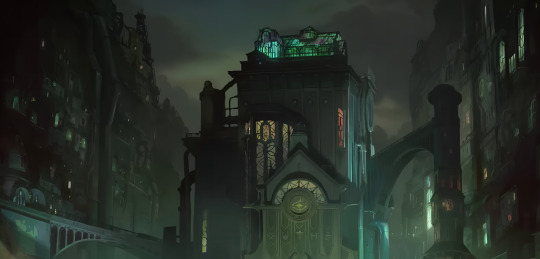

Bonus: I don't understand why people make such a big deal over Silco employing children in the shimmer factory like he invented child labor or something. Child labor has been a thing in Zaun at least since Piltover has been oppressing it. Silco and Vander worked in dangerous conditions in the mines as children. Ekko worked for Benzo as a child. Vander's kids steal from people to make a living, they aren't doing much better. Silco didn't get rid of child labor but he did ensure the profit from it went towards the Undercity rather than the greedy hands of Piltover.
#silco#arcane silco#silco arcane#arcane#arcane season two#arcane season 2#character analysis#arcane netflix#arcane news#arcane lol#arcane league of legends#arcane show#analysis arcane#arcane analysis#eye of zaun#arcane zaun#zaun#firelight#firelights#arcane vander#vander arcane#silco and vander#jinx and silco#jinx and sevika#sevika arcane#convergence#league of legends#league of legends convergence#jinx#arcane details
126 notes
·
View notes
Text
Geology and the Economy/Trade in Your Fictional World: Explained
Hi, I'm Bird. I am a geology Ph.D. student and I love reading fiction and playing videogames, however something that can really pull me out of a fictional universe is a lack of understanding of basic geology, and how that would influence your fictional world. Today I will cover geology that can effect trade, some landscape features, and construction!
Things that are typically necessary/desired in a fictional world are building materials, gemstones/precious metals, and fossil fuels/ sources of energy. However, a lot of these things are not found together, and they typically have some features to make them more distinct in terms of landscape, so lets talk about it!
Gemstones/ Precious metals and landscape features
Typically, gemstones can be found in two different rock types. The first is intrusive igneous rocks (magma that slowly cooled underground to form course-grained rocks like granite) and high grade metamorphic rocks (rocks that got put under intense heat and pressure under the earth's surface). Some minerals are more likely to form in particular conditions than others, but for the most part these minerals can be found interchangeably within both of these places. *Note: this is a gross oversimplification but we are starting small
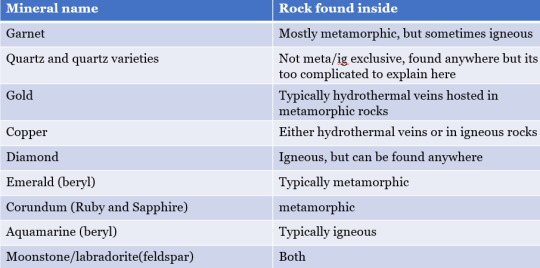
(Yes it is a shitty chart better pictures will come further in the post)
If you are writing these minerals based off and igneous deposit, good descriptions for the rocks would be speckled, with mineral grains of about the same size and varying in color. They should NOT be striated, and they will often form bald (unforested) cliffs that are typically rounded and not jagged.
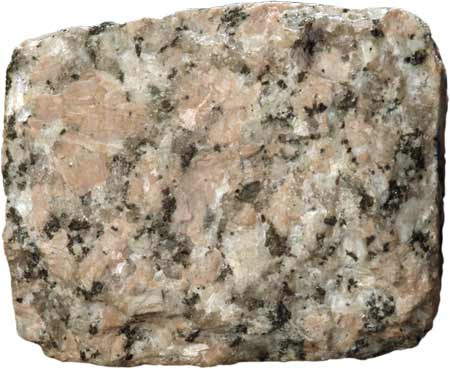

If you are writing with metamorphic rocks, you would expect these rocks to be layered, typically having light and dark layers with some minerals possibly being much larger than the others surrounding it. These textures can definitely (sometimes) be observed from a distance.


*Final notes about minerals* Quartz varieties are difficult, quartz can be found in volcanic, metamorphic, sedimentary, and intrusive igneous settings. If you are writing about agate specifically it is almost always volcanic in nature.
Diamonds are found in volcanic ash deposits called kimberlites, these deposits can occur in any rock type, so while they are igneous, they can be found anywhere. They have zero connection to the surrounding rocks.
2. Fossil Fuels
If a region is producing oil or coal, it is going to be from a sedimentary environment that is very rich in ancient plant material (like millions of years old). A unique feature of these locations would be finding lots of plant fossils, and rocks that can be found in association with these would be sandstone, shale, conglomerates/breccias, and limestones. Sedimentary rocks form in layers, so if exposed the layers will be very visible from a distance. You can also get unique features due to preferential weathering (fancy way of saying some rocks are harder than others, so when exposed to the same weather some rocks will break down faster than others). Also, natural oil seeps are a thing in places where natural oil is prevalent, but I couldn't find a good picture sorry.
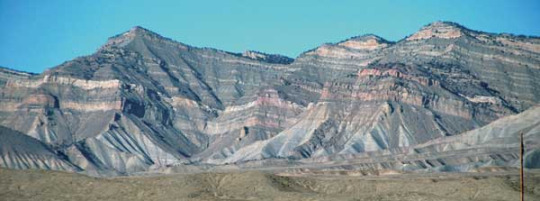
3. Building Resources
based on the rocks found in each region, the buildings will be made out of different materials, so lets breakdown what building materials would be used based off what rocks are present in the location.
Sedimentary rocks- lots of options here, so I will just info dump. If the region is drier, limestone is a good choice, historically may desert areas use limestone, it is soft and easy to carve, but it will dissolve slowly with rain. Sandstone is a durable rock that can be used, but it is very hard as it is made of quartz. Clay! shale breaks down in humid environments and will often make clay, this is a great, amazing building resource that could drive economy.
Metamorphic rocks- Marble.... if you want to make luxurious marble temples, metamorphic rocks are a must! Other comments, metamorphic rocks will often have layers of weaker minerals and stronger minerals, that means they will break along a defined surface. A lot of older houses in the Italian Alps (Aosta Valley) use these rocks for roofing. Slate roofing is also common in a lot of places, slate is formed from really low grade metamorphism, so this resource can be available in both sedimentary and metamorphic locations within reason.
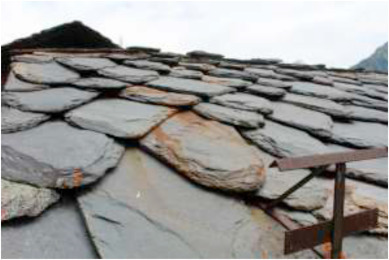
Igneous- Granite (light) and Gabbro (dark) is very hard and therefore it is used frequently in countertops today. This is also important because these rocks will take a high shine from polishing. Igneous rocks are also perfect for making cement! Volcanic ash mixed with quicklime and salt water is the recipe for roman concrete which is arguable much better than current day concrete but otherwise doesn't offer much more benefit.


Thank you if you made it this far, I want to make more guides in the future to hopefully cover more geology topics that can influence a story (possibly natural disasters and associated landscape features for subtle foreshadowinggggg)
This guide is very simplified! It is supposed to cover a lot of information for people who may not know a lot about geology, but are interesting in creating fictional universes! If you know a lot about geology already, please avert your eyes, or comment something additional!
#geology#rocks#science#creative writing#dnd#worldbuilding#writeblr#fictional world#dnd worldbuilding#writerscommunity#writing resources#writing tips#writing prompt#stem#worldbuilding stuff
534 notes
·
View notes
Text
That poll of midwestern dishes is so funny cause all the replies from people elsewhere are like "these cannot be real" but the actual food history of the midwest behind that is so interesting. When midwest what invaded and settled by the US, it was expanded principally as a commercial enterprise of large companies getting granted allotments from the government. It was done not only to fuel land speculation on a previously unheard of level but to create new markets for the eastern states to sell their goods to.
So when the midwest was settled its primary economy was what of farmers who grew crops primarily to sell back east to be able to buy goods that came east and to the growing industrial cities of the region, including food. People still grew crops that they would eat (corn on the cob is a classic), but that was by and large to supplement what was bought rather than subsisting on it.
So the dominant things you see in primarily white settler midwestern food is mass produced, commodities like ground beef, salted pork, canned beans, and macaroni. Well known sweets are generally things that can easily be whipped up with eggs, flour, and sugar like sugar cream pie and butter cookies. And this continues right up to today with many of the main recipes people learn to make are casseroles, stews, and hideous looking but unbelievably delicious mixes of processed foods. Most other dishes more complicated than that you can trace directly to Betty Crocker.
But the thing is, this food history is one primarily the white settlers who were able to buy land and committed the ongoing genocide that created the white midwest. On the ground, indigenous dishes both ones that existed prior to colonization and ones like fry bread from colonization still persist especially in the norther midwest. Black dishes are common across the region, especially in cities where Black immigrants fled to during the Great migration. Tex-mex and Central American food is incredibly common.
So when midwest food is talked about, it's primarily the simple, commodity based dishes of the white settler population that are acknowledged. Food from other cultures, despite being more common than the white food dishes in large parts of the midwest, is either ignored as not really midwestern or appropriated. To the point that even now corn is primarily associated in the US with the white dominated commercial farms rather than as one of the primary foods of the Indigenous population that made this region so prosperous before and during colonization.
1K notes
·
View notes